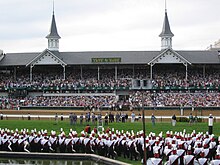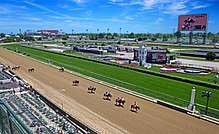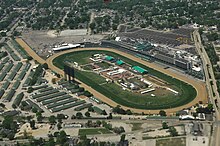|
Churchill Downs
Churchill Downs is a horse racing complex located on Central Avenue in south Louisville, Kentucky, United States, famed for hosting the annual Kentucky Derby. It officially opened in 1875 and was named for Samuel Churchill, whose family was prominent in Kentucky for many years.[1] The first Kentucky Derby, a Thoroughbred sweepstakes and part of today's horse racing Triple Crown, and the first Kentucky Oaks were held in the same year. Churchill Downs has also hosted the renowned Breeders' Cup on nine occasions, most recently on November 2 and 3, 2018.[2] The racetrack is owned and operated by Churchill Downs Incorporated. With the infield open for the Kentucky Derby, the capacity of Churchill Downs is roughly 170,000.[3] In 2009 the Horseplayers Association of North America introduced a rating system for 65 Thoroughbred racetracks in North America, which ranked Churchill Downs number 5 on its list. In 2014, prior to the start of their spring meet, Churchill Downs announced an increase in parimutuel takeout rates. As a result of the takeout increase, Churchill Downs ranked number 22 in that year's Horseplayers Association of North America Track Ratings.[4] History The track is named for John and Henry Churchill, who leased 80 acres (32 ha) of land to their nephew, Colonel Meriwether Lewis Clark Jr. (grandson of explorer William Clark). Clark was president of the Louisville Jockey Club and Driving Park Association, which formed in 1875. His father-in-law, Richard Ten Broeck, was an accomplished horse breeder and trainer, and introduced Clark to horse racing, attending the English Derby at Epsom Downs outside London.  Churchill Downs filled a void in Louisville left by the closing of Oakland and Woodlawn, two earlier race courses. The then-rural location was along Louisville and Nashville Railroad tracks, allowing for easy transport of horses. Clark, who preferred longer races to the relatively short ones that had become popular by the 1890s, was running short of funds, and in 1894 sold the track to a syndicate led by William E. Applegate.[5] The new ownership would soon institute many changes, such as commissioning the famous twin spire grandstand in 1895, shortening the length of the signature race to its modern 1+1⁄4 miles (2.0 km) in 1896, and adorning the winner of the Derby with a garland of roses, a tradition that also began in 1896.[6]  In early 1902, Applegate, who had made his fortune as a bookmaker, turned over the day-to-day operation of the track to Charles F. Grainger, then the mayor of Louisville, in an effort to move Churchill Downs away from being primarily known for gambling. Among the new people Applegate brought on board to help him run the track was Col. Matt Winn of Louisville. Churchill Downs prospered and the Kentucky Derby then became the preeminent stakes race for three-year-old thoroughbred horses in North America. During that early period, a new clubhouse was built in order to promote social interaction and new events such as steeplechases, automobile races and band concerts. The State Fair was held on the grounds, featuring the odd spectacle of two locomotives being intentionally crashed head-on in the infield.  On June 5, 1907, African American jockey James Lee set a record that has never been beaten when he won the entire six-race card at Churchill Downs. In 1908, parimutuel betting machines were introduced as gambling began to be less controversial again, and the wagering portion of the track's business became more profitable. Churchill Downs was designated a National Historic Landmark in 1986. On Friday, June 19, 2009, Churchill Downs hosted its first-ever night race with an attendance of over 27,000. Churchill Downs ventured into the music business, organizing the inaugural HullabaLOU Music Festival, held on the weekend of July 23–25, 2010. The track had planned to make this an annual event to compete with other summer music festivals. HullabaLOU attracted 78,000 people but that fell short of the more than 100,000 expected by the company. The company attributed this to the brutal heat, but others cited high ticket prices in a poor economy. The entertainment division lost more than $5 million in its first year and was discontinued.[7]  On Wednesday, June 22, 2011, an EF2 tornado hit the Louisville area, striking the stables and chapel at Churchill Downs, at EF1 intensity.[8] Several stables were badly damaged, as was the chapel. Over 200 horses had to be evacuated from the damaged stables and be relocated to other stables that were not damaged by the tornado. The tornado did not cause any damage to the twin spires or the clubhouse.[9] Thurby is a portmanteau for Thursday plus Derby, and this name for the Thursday racing in Derby week has been recognized by Churchill Downs since 2014.[10] In June 2023, following the investigation by Kentucky Horse Racing Commission and Horseracing Integrity and Safety Authority over twelve horse fatalities since April 27, 2023, Churchill Downs transferred its spring-summer racing meet to Ellis Park Race Course in Henderson, Kentucky while it re-evaluated its safety measures.[11] Graded eventsThe following Graded events were held at Churchill Downs in 2023 and 2024. Grade I Grade II Grade III
Facilities  The twin spires atop the grandstands are the most recognizable architectural feature of Churchill Downs and are used as a symbol of the track and the Derby. They were designed by the renowned Louisville architectural firm D.X. Murphy & Bro. who were prolific in the city, markedly so for their philanthropic work with the Catholic Church.[12] Today, Churchill Downs covers 147 acres (59 ha). The usual number of people seated at the derby is 50,000 people, though crowds can reach over 150,000 on Derby day. The dirt oval main track, on which the Derby is run, is one mile (1.6 km) in circumference and is 79–80 feet (24.1–24.4 m) wide, with a 120-foot-wide (37 m) section for the starting gate. A turf track, inside the main track, is 7⁄8 mile (1.4 km) in circumference and 80-foot (24 m) wide. From 2001 to 2005, Churchill Downs underwent a three-and-a-half year, $121 million renovation. The clubhouse was replaced, 79 luxury suites were added, and the historic twin spires were refurbished. One of the additions in the clubhouse was a 36-foot (11 m) mural by Pierre Bellocq depicting all 96 jockeys to win the Kentucky Derby from 1875 to 2004. In summer 2008 the same artist added another mural depicting all of the trainers and updating the Jockey's painting, adding Calvin Borel and Edgar Prado to it. These updates are done yearly to accommodate new winning trainers and jockeys. The new design has been somewhat controversial since the new suites block full view of the spires from most angles.[13]  Racing at Churchill Downs occurs in three meets though for the majority of its existence there were only two meets per year. The spring meet starts one week before the Derby and continues until early July. The Kentucky Derby is held the first Saturday in May and the Kentucky Oaks is run on the Friday before the Derby. A fall meet picks up in late October and closes Thanksgiving weekend in late November. Night races were established in 2009. A third meet in September was added in 2013. In addition to the track, clubhouse and stables, Churchill Downs also contains the Kentucky Derby Museum which focuses on the history of the Kentucky Derby and Churchill Downs. The museum also contains a number of exhibits exploring the training and racing of thoroughbred horses. It includes a 360-degree cinema that shows the short film "The Greatest Race", a documentary about the Kentucky Derby. The museum is normally open year-round. In October 2013, Churchill Downs began installing a new, ultra high-definition video board built by Panasonic, which became operational in time for the 2014 Kentucky Derby. Called "The Big Board", it measures 171 feet (52 m) wide and 90 feet (27 m) high, with the bottom edge 80 feet (24 m) off the ground, and weighs 1,200,000 pounds (540 t). It was constructed along the outside of the backstretch of the dirt course facing the grandstand and infield. At the time, it was the largest ultra high-definition video board ever constructed. At the same time, 750 speakers were installed around the track.[14] Churchill Downs has had several renovation projects since the early 2010s, the most notable being a new paddock being designed in a two-year project leading up to the 150th Kentucky Derby.[15][16] People associated with Churchill Downs
Chief executive officersFrom 1875 through 2019, Churchill Downs has had 12 CEOs.[17]
Track announcers
TV personalities
See also
Notes
References
External linksWikimedia Commons has media related to Churchill Downs. |
||||||||||||||||||||||||


